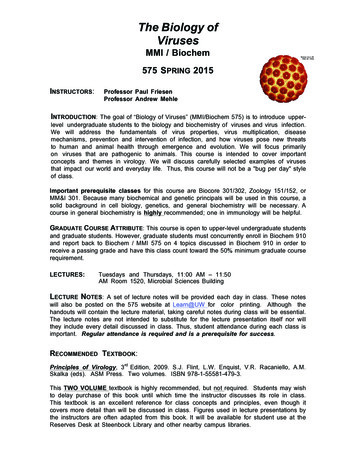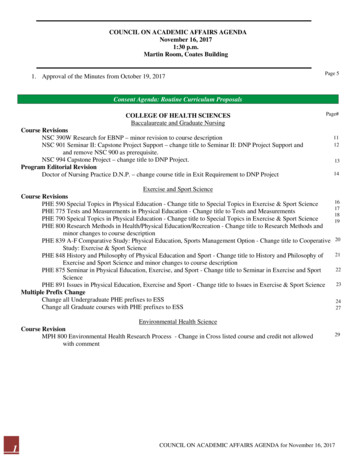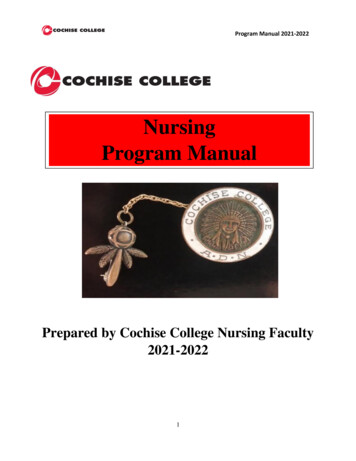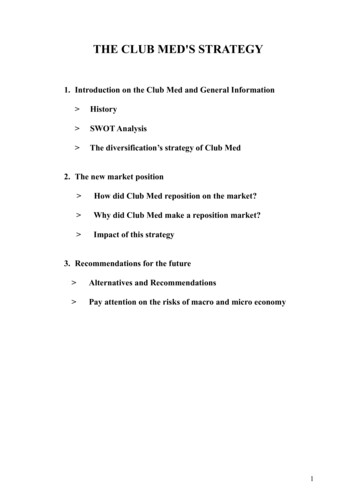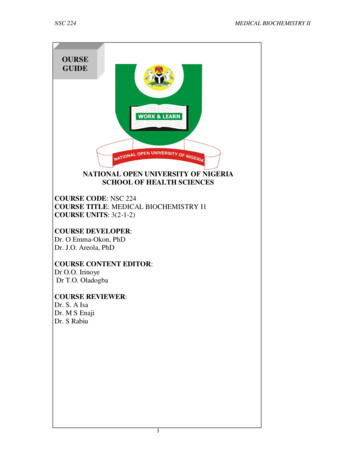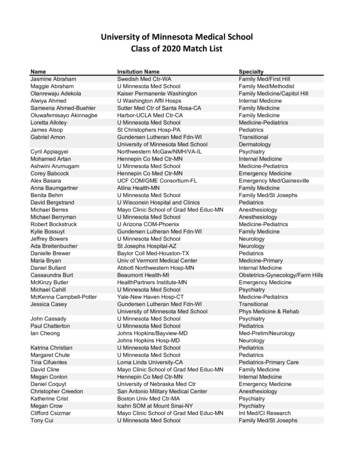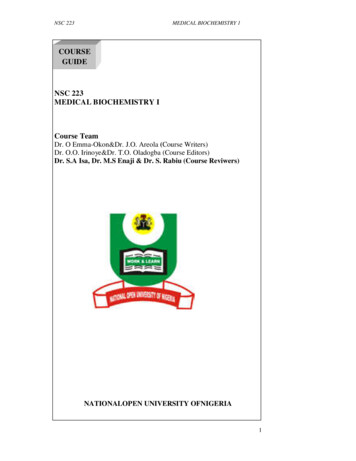
Transcription
NSC 223MEDICAL BIOCHEMISTRY 1COURSEGUIDENSC 223MEDICAL BIOCHEMISTRY ICourse TeamDr. O Emma-Okon&Dr. J.O. Areola (Course Writers)Dr. O.O. Irinoye&Dr. T.O. Oladogba (Course Editors)Dr. S.A Isa, Dr. M.S Enaji & Dr. S. Rabiu (Course Reviwers)NATIONALOPEN UNIVERSITY OFNIGERIA1
NSC 223MEDICAL BIOCHEMISTRY INational Open University of NigeriaHeadquartersUniversity VillagePlot 91, Cadastral Zone,Nnamdi Azikiwe ExpresswayJabi AbujaLagos Office14/16 Ahmadu Bello WayVictoria Island, LagosEMAIL: lished byNational Open University of NigeriaPrinted 2015ISBN: 978-058-886-4All Rights Reserved2
NSC 223CONTENTSMEDICAL BIOCHEMISTRY 1PAGEIntroduction.Course Aims.Course Objectives.Working through the Course.Course Materials.Study Units.Reference Textbooks.Equipment and Software Needed to Access Course.Number and Places of Meeting.Discussion Forum.Course Evaluation.Grading Criteria.Grading Scale.Schedule of Assignments with Dates.How to Get the Most from this Course.viiiivivivivivvviviviviiviiviiviiiviii3
NSC 223MEDICAL BIOCHEMISTRY IINTRODUCTIONThis course is medical biochemistry. Medical biochemistry is a subset ofgeneral biochemistry. The course is designed to introduce beginners tothe concepts of biochemistry which deal with the chemical reactions inbiological systems. In this course, you will learn the biochemicalactivities that occur inside the cell and how these activities determineour state of health and what happens in disease. The reason why we fallsick and the root causes of disease will be clearer to you at the end of thecourse. Take a second look at yourself in the mirror; note the shape ofyour face, the shape of your nose, ear and lips. Examine yourcomplexion, your height and the colour of your hair. Now look at yourmother carefully, how many of these features do you share with her? Dothe same to your father. Do you observe any features not shared witheither of your parents? If there is any, it may be the feature you inheritedfrom your grandparents. Scientific basis for this simple experiment willbe explained to you in this course. Diseases can be caused by microorganisms, what we eat, drink and by our lifestyle; it can also beinherited from our parents. You will be in a position to explain thesource or cause of a particular disease and the mechanism of itstreatment if you understand the biochemistry of human body. Theknowledge that will be acquired in this course will assist you inunderstanding the effects of drugs on the body and the effects of ourbody on the drugs we use for therapeutic purposes. The concludingaspects of this course highlight the roles of biocatalysts as mediators ofcellular reactions and the importance of vitamins in maintaining lifeprocesses.COURSE AIMThe aim of this course is to build your foundation for application of theunderstanding of the basic chemical processes of the body in health anddiseases.COURSE OBJECTIVEAt the completion of this course, you should be able to: explain the context of medical biochemistry in health and diseaseconditions. .WORKING THROUGH THIS COURSEThe course will be delivered adopting the blended learning mode, 70%of online but interactive sessions and 30% of face-to-face duringlaboratory sessions. You are expected to register for this course online4
NSC 223MEDICAL BIOCHEMISTRY 1before you can have access to all the materials and have access to theclass sessions online. You will have hard and soft copies of coursematerials, you will also have online interactive sessions, face-to-facesessions with instructors during practical sessions in the laboratory. Theinteractive online activities will be available to you on the course link onthe Website of NOUN. There are activities and assignments online forevery unit every week. It is important that you visit the course sitesweekly and do all assignments to meet deadlines and to contribute to thetopical issues that would be raised for everyone’s contribution.You will be expected to read every module along with all assignedreadings to prepare you to have meaningful contributions to all sessionsand to complete all activities. It is important that you attempt all theTutor-Marked Assignment (TMA) and other Self-Assessment Questions(SAQ) at the end of the Module or Units to help your understanding ofthe contents and to help you prepare for the in-course tests and the finalexamination. You will also be expected to keep a portfolio where youkeep all your completed assignments.STUDY UNITSThis course is the first of two courses that you will take and divided into3 Modules of 14 study units.Module 1General Introduction to Medical BiochemistryUnit 1Unit 2Unit 3Introduction to Physiological and Pathological ChemistryCell Structure and Functions 1Functions of the Cell Membrane and the OrganellesModule 2Chemistry of BiomoleculesUnit 1Unit 2Unit 3Unit 4Unit 5Unit 6Unit 7Unit 8Chemistry of CarbohydratesChemistry of Carbohydrates (II)Water, Acids, Bases and BufferChemistry of Amino Acids and Proteins (I)Chemistry of Amino Acids and Proteins (II)Chemistry of LipidsChemistry of Nucleic acids IChemistry of Nucleic acids IIModule 3Basic EnzymologyUnit 1Unit 2Unit 3Introductory EnzymologyEnzyme Kinetics IEnzyme Kinetics II5
NSC 223MEDICAL BIOCHEMISTRY IBibliographyMurry, R. K., Bender, D. A., Bothan, K.M., Kennelly, P. J., Rodwell, V.W. and Well, P. A.(2015). Harper’s Illustrated Biochemistry (30 thEdition) McGraw-Hill Medical.Nelson, D. L. and Cox, M. M. (2012). Lehninger Principles ofBiochemistry (6th edition) WHFreeman.Pamela, C. C., Richard, A. H. and Denise, R. F. (2013). Lippincott’sIllustrated Reviews Biochemistry (6th edition) Lippincott Williams &Wilkins.Marks' Essentials of Medical Biochemistry: A clinical approach. 2ndEdition Copyright 2007 Lippincott Williams & Wilkins.Garrett and Grisham Biochemistry, 2 nd Edition. Harcourt College PubLippincott Biochemistry Fourth Edition (2010).Robert K. Murray, MD, PhD. ‘Harper’s Illustrated Biochemistry’.Twenty-Eighth Edition. 2009Devlin T.M. (2010) Textbook of Biochemistry with Clinical Correlation7thEdition. JohnWiley&SonsInc.Davis, Jack. 2019. An Introduction to Enzyme Kinetics. NewsMedical, viewed 25 August 2021, duction-to-EnzymeKinetics.aspx.Factors Affecting Enzyme Activity: 6 Factors (biologydiscussion.com)retrieved August 28, 2021Biologydictionary.net Editors. “Animal Cell.” Biology //biologydictionary.net/animal-cell/.6
NSC 223MEDICAL BIOCHEMISTRY 1COURSE REQUIREMENTS AND EXPECTATIONS OFYOUAttendance of 95% of all interactive sessions, submission of allassignments to meet deadlines; participation in all CMA, attendance ofall laboratory sessions with evidence as provided in the log book,submission of reports from all laboratory practical sessions andattendance of the final course examination. You are also expected to:1.2.3.4.5.Be versatile in basic computer skillsParticipate in all laboratory practical up to 90% of the timeSubmit personal reports from laboratory practical sessions onscheduleLog in to the class online discussion board at least once a weekand contribute to ongoing discussions.Contribute actively to group seminar presentations.EQUIPMENT AND SOFTWARE NEEDED TO ACCESSTHIS COURSEYou will be expected to have the following tools:1.2.3.4.5.A computer (laptop or desktop or a tablet)Internet access, preferably broadband rather than dial-up accessMS Office software – Word PROCESSOR, Power point,SpreadsheetBrowser – Preferably Internet Explorer, Moxilla FirefoxAdobe Acrobat Reader.NUMBER AND PLACES OF MEETING (ONLINE, FACETO-FACE, LABORATORY PRACTICALS)The details of these will be provided to you at the time ofcommencement of this course.DISCUSSION FORUMThere will be an online discussion forum and topics for discussion willbe available for your contributions. It is mandatory that you participatein every discussion every week. You participation link you, your face,your ideas and views to that of every member of the class and earns yousome mark.7
NSC 223MEDICAL BIOCHEMISTRY ICOURSE EVALUATIONThere are two forms of evaluation of the progress you are making in thiscourse. The first are the series of activities, assignments and end of unit,computer or Tutor-Marked Assignment, and laboratory practicalsessions and report that constitute the continuous assessment that allcarry 30% of the total mark. The second is a written examination withmultiple choice, short answers and essay questions that take 70% of thetotal mark that you will do on completion of the course.Students’ evaluation: you will be assessed and evaluated based on thefollowing criteria: In-course examinationIn-course examination will come up in the middle of thesemester. This would come in form of Computer MarkedAssignment. This will be in addition to one compulsory TutorMarked Assignment (TMA) and three Computer MarkedAssignment that comes as specified after the modules.Laboratory practical: Attendance, record of participation andother assignments will be graded and added to the other scoresform other forms of examinations.Final examination: The final written examination will come upat the end of the semester comprising essay and objectivequestions covering all the contents covered in the course. Thefinal examination will amount to 60% of the total grade for thecourse.Learner-Facilitator evaluation of the courseThis will be done through group review, written assessment oflearning (theory and laboratory practical) by you and theGRADING CRITERIAGrades will be based on the following percentagesTutor- Marked Assignments10%Computer- marked Assignment10%Group assignments5%40%Discussion Topic participation5%Laboratory practical10%End-of-Course examination60%GRADING SCALEA 70-1008
NSC 223MEDICAL BIOCHEMISTRY 1B 60 - 69C 50 - 59F 49HOW TO GET THE MOST FROM THIS COURSEi.ii.iii.iv.v.vi.vii.viii.ix.x.xi.Read and understand the context of this course by readingthrough this Course Guide paying attention to details. You mustknow the requirements before you will do well.Develop a study plan for yourself.Follow instructions about registration and master expectations interms of reading, participation in discussion forum, end of unitand module assignments, laboratory practical and other directivesgiven by the course coordinator, facilitators and tutors.Read your course texts and other reference textbooks.Listen to audio files, watch the video clips and consult websiteswhen given.Participate actively in online discussion forum and make sure youare in touch with your study group and your course coordinator.Submit your assignments as at when due.Work ahead of the interactive sessions.Work through your assignments when returned to you and do notwait until when examination is approaching before resolving anychallenge you have with any unit or any topic.Keep in touch with your study centre and School of HealthSciences’ website as information will be provided continuouslyon this site.Be optimistic about doing well.SUMMARYThe Course NSC 223 (Medical Biochemistry I) is a compulsory coursefor Nursing Science students. The course content is prepared in modulesand units as well as related practicals. It covers the basic requirementsfor teaching medical biochemistry to Nursing Science students. It isexpected that the foundation provided in NSC 223 would find relevanceas students advance in their course of study. The minimum pass grade is50% made up of assignments and examination components9
NSC 223MEDICAL BIOCHEMISTRY IMAINCOURSECONTENTSModule 1Unit 1PAGEGeneral Introduction to MedicalBiochemistry.1Unit 2Unit 3Introduction to Physiological and PathologicalChemistry. 1Cell Structure and Functions .5Membrane structure abd organisation . 15Module 2Chemistry of Biomolecules.21Unit 1Unit 2Unit 3Unit 4Unit 5Unit 6Unit 7Unit 8Chemistry of Carbohydrates.Chemistry of Carbohydrates (II).Water, Acids, Bases and Buffer.Chemistry of Amino Acids and Proteins (I).Chemistry of Amino Acids and Proteins (II).Chemistry of Lipids.Chemistry of Nucleic Acids I Chemistry of Nucleic Acids II .2129333850606975Module 3Basic Enzymology.80Unit 1Unit 2Unit 3Introductory Enzymology. 80Enzyme Kinetics I. 91Enzymes Kinetics II. 9610
NSC 223MEDICAL BIOCHEMISTRY 1MODULE 1Unit 1Unit 2Unit 3GENERAL INTRODUCTION TOMEDICAL BIOCHEMISTRYIntroduction to Physiological and Pathological ChemistryCell Structure and FunctionsFunctions of the Cell MembraneUNIT 1INTRODUCTION TO PHYSIOLOGICAL ANDPATHOLOGICAL ObjectivesMain Content3.1Definition of Biochemistry3.2Breakthrough in Biochemistry3.3Relevance of Medical Biochemistry to other Life Sciences3.4Branches of BiochemistryConclusionSummaryTutor-Marked AssignmentReferences/Further Reading1.0INTRODUCTIONThis unit introduces you to medical biochemistry with someexplanations of the relevance of the course to Nursing Science. Youwill also be exposed to different branches of biochemistry.2.0OBJECTIVESAt the end of this unit, you should be able to: Define medical biochemistryMention the major breakthrough in the field of biochemistryExplain the relevance of biochemistry to nursing, medicine andother health sciencesDescribe different branches of biochemistry.11
NSC 2233.0MAIN CONTENT3.1Definition of BiochemistryMEDICAL BIOCHEMISTRY IBiochemistry is the study of chemical processes in living organisms. Itcan also be defined as the application of chemistry to the study ofbiological processes in living organisms. Biochemistry is both a lifescience and a chemical science; it explores the chemistry of livingorganisms and the molecular basis for the changes occurring in livingcells.Medical biochemistry can be described as a branch of Generalbiochemistry; its scope is not as broad as general biochemistry. Medicalbiochemistry is defined as the study of biochemical processes that occurwithin the human body in relation with their application in the field ofmedicine. Millions of complex chemical reactions are going on in thehuman body at any given time, ranging from the balance of theendocrine system to the storage and utilization of fuel molecules such asglucose. By studying and understanding these highly complex reactions,medical biochemists have found better ways to fight infections anddiseases at the molecular level. Since an Engineer cannot repair avehicle if he does not understand how it works, so a Nurse mustunderstand how human body works before she can treat her patienteffectively.Much of biochemistry deals with the structures and functions of cellularcomponents such as proteins, carbohydrates, lipids and nucleic acidscollectively known as biomolecules. The main focus of medicalbiochemistry is in understanding how biological molecules give rise tothe processes that occur within living cells, which in turn relates greatlyto the study and understanding of the whole organism (human being).3.2Breakthrough in BiochemistryOur present knowledge of human body came from series of experimentsand research conducted several years ago. Transfer of geneticinformation from one generation to the next was not thoroughlyunderstood until the major breakthrough of 1953/54. One of the majorbreakthroughs in medical biochemistry was the discovery of an accuratemodel of DEOXYRIBONUCLEIC ACID (DNA) by James Watson andFrancis Crick in 1953. This discovery opened up possibilities in therealm of medical biochemistry that had been inaccessible until that time.The human genome was mapped completely in 2003 as a result of the 13year Human Genome project (HGP). Since then, medical biochemistshave had access to vital genetic information which has allowed for12
NSC 223MEDICAL BIOCHEMISTRY 1manipulation within the cell nucleus. They are also finding ways toisolate harmful traits within human DNA, and have found methods ofsometimes causing them to completely shut down prior to manifestation.Intense effort on the parts of the scientific and medical communitiesapplied to biochemical research has led to the discovery of manyvaccines, anti-depressants and other useful medicinal drugs. These drugsoften work hand-in-hand with the chemical makeup of the humananatomy. Without medical biochemistry, much of modern medicinewould not be practiced as it is known today.3.3Relevance of Medical Biochemistry to Other HealthSciencesMedical Biochemistry provides foundation for other health sciencessuch as medicine, Nursing, pharmacy, microbiology etc. Variousmethods are used by Biochemists to isolate, purify, characterise andstudy the reactions of all cellular components. Biochemists havecontributed greatly to the discovery of new drugs to treat chronicdiseases such as cancer, viral infections and metabolic disorders. Theyare able to do this because they have thorough understanding of whathappens at the molecular level i.e. inside the cell.3.4Branches of Biochemistryi.Toxicology: This field studies the adverse effects of toxic orforeign chemical substances on the organisms. Environmentaland food toxicology also fall under this branch of biochemistry.Enzymology: The study of enzymes, their functions, deficiencyand the consequence of such deficiency in diseases.Molecular biology and Biotechnology: This field evolved directlyfrom Nucleic acid biochemistry and it involves manipulation ofDNA to improve drug research and solve health problems. It haswide applications in other fields of science whichincludescancer research.Lipid and carbohydrate biochemistry: These fields study thebiochemical basis of metabolic disorders such as diabetes, obesityand Cardiovascular diseases.Natural products biochemistry: This is a new area of research inbiochemistry; it evolved as a result of interest of scientists acrossthe world in searching for new drugs from plants. Quinine andArtesunate (anti-malaria drugs) were isolated from plants.Bioinformatics: Bioinformatics is a shortened form of “Biologicalinformatics”. It is ofte focused on obtaining biologically orienteddata such as nucleic acid and protein sequence, structures,functions, pathways ad their interactions.ii.iii.iv.v.vi.13
NSC 223MEDICAL BIOCHEMISTRY ISelf-Assessment ExercicesHihglight the roles of Medical Biochemistry to Nursing Sciences.4.0CONCLUSIONThis introductory unit has shown that biochemistry as a study of thechemical processes in the body has made many breakthroughs that ishelping in better understanding and planning of care for people. The fivemain branches of biochemistry presented have different dimensions tothe discourse of health and health care.5.0SUMMARYIn this unit, you have learnt about the following: Definition of BiochemistryBreakthrough in BiochemistryRelevance of Medical Biochemistry to other health SciencesBranches of Biochemistry.6.0TUTOR-MARKED ASSIGNMENT1.2.3.4.7.0What is biochemistry?Why is it important for nursing students to study biochemistry?Assuming there were no biochemists in the world up till year2010, do you think medicine and nursing sciences will bepracticed the way they are practiced today? Explain your answer.Mention 3 branches of biochemistry and explain the area ofbiochemistry they study.REFERENCES/FURTHER READINGNelson, D. L. and Cox, M. M. (2012). Lehninger Principles ofBiochemistry (6th edition) WHFreeman.Marks' Essentials of Medical Biochemistry: A clinical approach. 2ndEdition Copyright 2007 Lippincott Williams & Wilkins.14
NSC 223UNIT 2MEDICAL BIOCHEMISTRY 1CELL STRUCTURE AND ObjectivesMain Content3.1The Definition and Structure of Animal Cell3.2Differences between Prokaryotes and Eukaryotes Cells3.3Types, Classification and Life -Span of Animal Cells3.4The Chemical Composition of Plasma MembranesConclusionSummaryTutor-Marked AssignmentReferences/Further Reading1.0INTRODUCTIONThe living cells we are discussing here is not different from the cell youlearnt in Biology when you were in secondary school. Cells are themonomeric unit through which the complex human body wasconstructed; my body and your body contain several billion cells!Biochemical arrangement of cells and how these cells interact toperform various functions in man are not only fascinating but also veryinteresting. Imagine the sensitivity of cells responsible for taste;different region of your tongue detects different taste.Some cells are replaced every 72 hours in our body while some spend upto ten years before they die. Also some cells remained in our bodythroughout our lifetime. It is important to understand the importance ofcompartmentalization in cells and the functions of various organellespresent in the cells. This knowledge will help you in subsequentmodules; most biochemical reactions take place inside the cell but indifferent organelles; for example, energy generation takes place insidethe mitochondria. Thorough understanding of cell structure will helpyou to understand the root causes of many diseases and the biochemicalmechanisms of their treatment. These mechanisms will also be relevantin other physiological courses you are going to offer.2.0OBJECTIVESAt the end of this unit, you should be able to: Define a cell and draw the structure of a typical animal cellDifferentiate between prokaryotic and eukaryotic cells15
NSC 223MEDICAL BIOCHEMISTRY I Describe the types, classification and life span of animal cellsDescribe the chemical composition of plasma membranes.3.0MAIN CONTENT3.1The Definition and Structure of Animal CellA living cell is defined as the fundamental unit of life and it is thesmallest unit capable of exhibiting the characteristics of life. Cell wasaccidentally discovered in 1665 by Robert Hooke while examining athin slice of cork under his new crude microscope. He observednumerous porous structures (dead cells made of cellulose found inplants) and named them CELLS (Latin, cellula means little room orsmall chamber). Further research later confirmed that all living thingsare composed of cells.Fig. 1: Structure of Animal Cell (source: Google images)Animal cells have different shapes and sizes; some are circular,spherical, cylindrical, Fibrous etc. Red blood cells called erythrocytesare one of the smallest animal cells while ova are among the largest. Interms of length, nerve cells are the longest. For ease of representation,circular structure is commonly used to illustrate the structure of animal16
NSC 223MEDICAL BIOCHEMISTRY 1cells. Study the structure of animal cell (Figure 2.1); take note of theorganelles shown in the structure (mitochondria, ribosome, Golgi,endoplasmic reticulum, and lysosome). These organelles have differentfunctions they perform in the cell; the functions will be discussed insubsequent section. A cell can be subdivided into 3 parts namely:i.The plasma membrane- The plasma membrane is also called thecell membrane, is the outer membrane common to all cells. Theplasma membrane defines the internal environment of the cell. Itis the thin cover that separates a cell from its environment, it alsoprotect the components of the cell from leaking. It prevents thefluid outside the cell called extracellular fluid (ECF) from mixingwith the fluid inside the cell called intracellular fluid (ICF).Plasma membranes regulate the materials that enters or leaves thecell, for this reason, it is said to be semi-permeable. In addition,the plasma membrane has some glycoproteins and glycolypids onits surface; these molecules serve as signal molecule betweencells.ii.The cytoplasm: This is the fluid-like space between the plasmaand nuclear membrane. Cytoplasm is the cavity where theorganelles are found. It provides space for the movement ofsynthesised products from one compartment to another for furtherprocessing. The organelles are suspended in the cytoplasm bycytoskeleton network that resemble nets.iii.Nucleus: The nucleus is the control center of the cell surroundedby two membranes – the outer and inner nuclear membraneenvelopes. The outer membrane is continuous with theendoplasmic reticulum.This is the most important part of the cell;the nucleus is always centrally located. Nucleus is very importantto the cell because it contains the genetic materials (DNA andRNA) that control all the activities of the cell. Nucleus regulatesthe rate and time of cell division. It also determines the materialsthat enter or exit the cell.iv.Endoplasmic reticulum (ER) - This is a network of tubular andflat vesicles. The tubules and vesicles are interconnected. Thereare two basic regions of endoplasmic reticulum: the smooth andthe rough endoplasmic reticulum. The rough endoplasmicreticulum contains ribosomes. The major function of theribosomes on the rough endoplasmic reticulum (RER) is thebiosynthesis of proteins for export to the outside of the cells andenzymes to be imported into cellular organelles such as thelysosomes. The major function of the smooth endoplasmicreticulum (SER) is the biosynthesis of lipids and steroidhormones.17
NSC 223MEDICAL BIOCHEMISTRY Iv. Mitochondria - The mitochondria are the cell’s power plant whereenergy is produced. The basic structure of the mitochondrion iscomposed of two lipid bilayer-protein membranes: an outer and innermembrane. The inner membrane is highly folded resulting in asurface area 3 to 5 times that of the outer membrane. The innermembrane is impermeable to ions and most metabolites.The aqueousspace enclosed by the inner membrane is called the mitochondrialmatrix. The major metabolic pathways involved in the oxidation ofcarbohydrates, lipids, amino acids, and special biosynthetic pathwaysinvolving urea and heme synthesis are located in mitochondrialmatrix. Mitochondria also contain specific DNA containing geneticinformation for synthesis of some mitochondrial proteins.vi. Lysosomes - These are single membrane vesicles with an internalfluid environment that is highly acidic (pH 2) containing a variety ofenzymes that catalyze the breakdown of cellular macromolecules andalso digest large particles such as retired mitochondria and bacterialcells ingested by the cell.vii.3.2Differences between Prokaryotes and Eukaryotes CellsThe electron microscope allowed classification of cells into two majorgroups, prokaryotes and eukaryotes based on the presence and absenceof the true nucleus. Eukaryotes have nucleus which is covered bynuclear membrane; Animals, plants and fungi belong to the eukaryotes.Prokaryotes have no typical nucleus (no true nucleus), bacteria and bluegreen algae belong to the prokaryotes. Eukaryotic cells are much largerthan prokaryotes, they also have a variety of other membrane boundorganelles in their cytoplasm, and example includes mitochondria,lysosomes, endoplasmic reticulum (ER) and Golgi complexes.18
NSC 2233.3MEDICAL BIOCHEMISTRY 1Types, Classification and Life -Span of Animal CellsThere are about 210 distinct human cell types and there are between 50and 100 trillion cells in adult human body. Animals grow as a result ofcell division and cell enlargement. All animals begin their existence as asimple cell i.e. fertilized egg. This cell divides into 2, 4, 8, 16, 32 etc. toproduce a body consisting of numerous cells. Ovum is the largest cellcell in man while red blood cell is the smallest.Multi-cellular organisms are able to specialise cells to perform specificfunctions. A group of such cells is a tissue and in animals these occursas four basic types namely epithelium tissues, nervous tissues, muscletissues and connective tissues. Several types of tissues work together asan organ to produce a particular function such as the pumping of bloodby the heart. This pattern continues to a higher level with several organsfunctioning as an organ system to allow for reproduction, digestion etc.Mult-icellular organisms consist of several organ systems.Cells within the human body have different lifespan based on the typeand function of that cell. Although some types of cells are short lived,others remain in person’s body for months, years or throughout life.Taste receptor cells in the mouth live for 10 days, one month for the skincells, 15 years for muscle cells and a lifetime for nerve cells.Normal red blood cell lives for about 3-4months while sickle shaped redblood cells live for only 10-20 days. White blood cells live for about ayear and sperm cells have a lifespan of about 3 days.3.4The Chemical Composition of Plasma MembranesPlasma membrane mainly compose of lipids and proteins. There is awide variation in lipid-protein ratio between different cell membranes.The functions performed by cell and t
Lippincott Biochemistry Fourth Edition (2010). Robert K. Murray, MD, PhD. 'Harper's Illustrated Biochemistry'. Twenty-Eighth Edition. 2009 Devlin T.M. (2010) Textbook of Biochemistry with Clinical Correlation 7th Edition. JohnWiley&SonsInc. Davis, Jack. 2019. An Introduction to Enzyme Kinetics .

